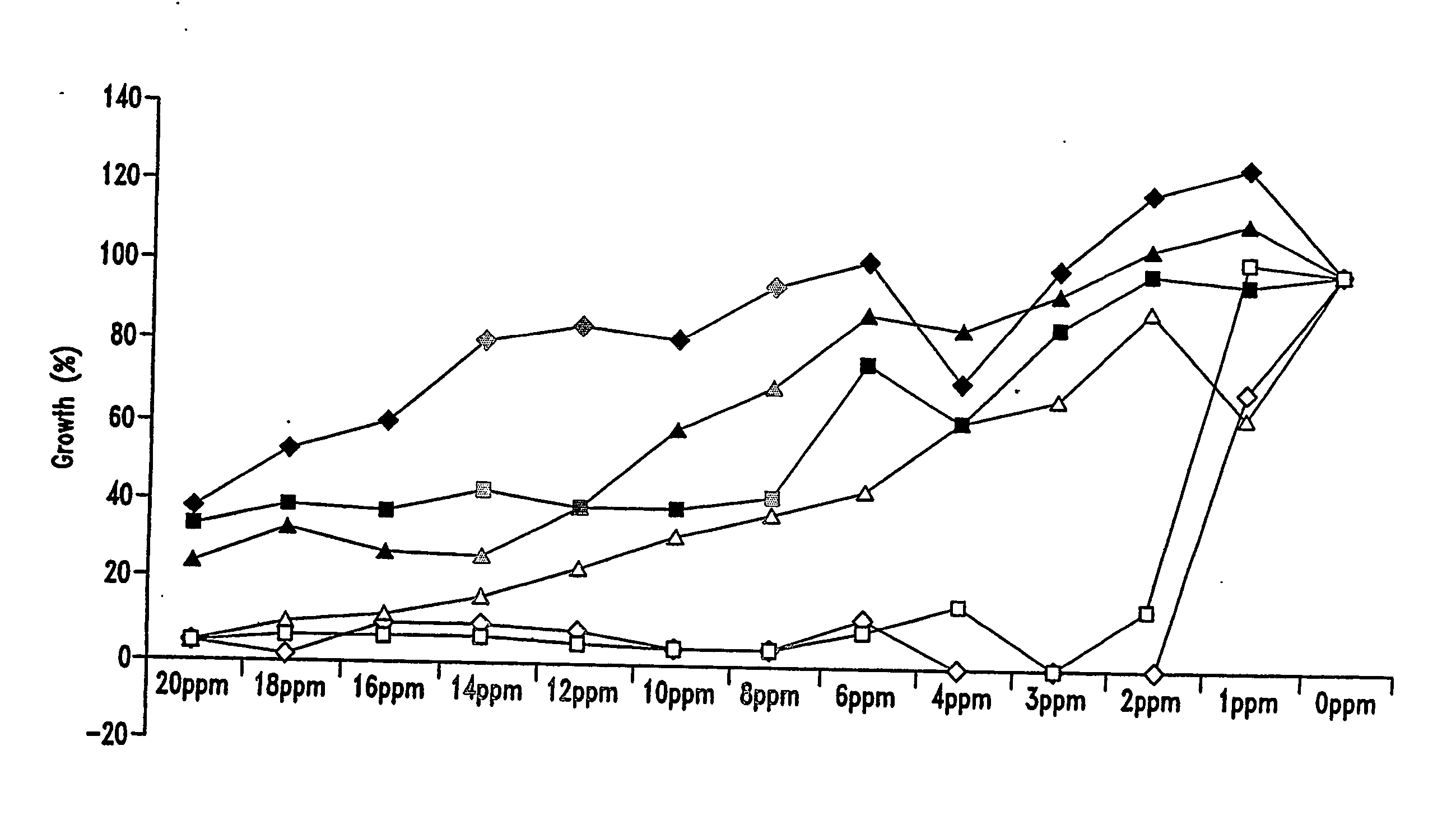Use of hop acids in fuel ethanol production
a technology of fuel ethanol and hop acid, which is applied in the direction of biofuels, milk preparations, alcoholic beverages, etc., can solve the problems of not being used or being used at low effectiveness, and achieve the effect of accurately doseing the amount of hop acid
- Summary
- Abstract
- Description
- Claims
- Application Information
AI Technical Summary
Benefits of technology
Problems solved by technology
Method used
Image
Examples
example 1
The Determination of the MIC
[0160] Alphahop®, a pure standardized highly concentrated resin composition of 92% α-acids; Betastab®, a pure standardized composition of 10% β-acids and essential hop oils; Redihop®, a pure, standardized solution of 35% rho-iso-α-acids; Isohop®, a pure standardized solution of 30% iso-α-acids; Hexahop Gold™, a pure standardized solution of about 8% or greater than 8% hexahydro-iso-α-acids and Tetrahop™, a pure standardized solution of 10% tetrahydo-iso-α-acids, all available from John I Haas, Inc. Haas Hop Products or Washington, D.C., USA, were tested to determine the concentration which would have an effect to reduce and / or eliminate acetic acid and / or lactic acid producing bacteria. Specifically used in the test were Lb. brevis and Lb. fermentum, although other types of bacteria may also be controlled.
[0161] As shown in FIGS. 1 and 2, Alphahop®, Betastab® and Redihop® inhibited growth compared with control tubes containing no hop compound (100% grow...
example 2
Determination of Effective Concentration and Optimum Concentration of Hop Acid
[0163] The effective concentrations required for THIAA, HHIAA and IAA did not differ much between Lb. brevis and Lb. fermentum. Lb. fermentum was more sensitive and at increased concentration all bacteria were killed, while numbers of Lb. fermentum could only be extensively reduced to a dimension of approximately 101-102 mL. The concentration at which bacterial numbers are minimal or eliminated is the “optimum concentration”.
[0164] As shown in FIG. 3, the effective concentration of THIAA for the inhibition of Lb. brevis was about 3 ppm. The optimum concentration at which viable cell numbers were extensively reduced was about 8 ppm. There was no improvement in reduction of viable cell numbers or improvement of ethanol yield with higher concentrations of THIAA. Concentrations above 12 ppm might promote resistance of Lb. brevis to THIAA. FIG. 4 shows the effective concentration of THIAA for inhibition of Lb...
example 3
Properties of Iso-α-acids, hexahydro-iso-α-acids and tetrahydro-iso-α-acids Compared to Conventional Antibiotics in Molasses Wort when Inoculated with 106 CFU / mL of Lactobacillus brevis or Lactobacillus fermentum
[0172] The results of the fermentation experiments with hop acids were compared to the results of fermentation experiments using the conventional antibiotics Penicillin G and Virginiamycin as disinfectants.
[0173] Penicillin is often used over 1.5 ppm in batch fermentations due to the possibility of induced enzymatic degradation of this antibiotic by some bacteria and the rather poor stability of penicillin G below pH 5 (Kelsall 1995). In this case, 0.25 ppm penicillin G was used, according to the manufacturer's instruction.
[0174] 0.5 ppm of Virginiamycin was used. Virginiamycin at a concentration of 0.5 ppm is effective against most lactic acid bacteria (Hynes S. H. et. al., J. Ind. Micro. & Biotech; 18 (4): 284-291, 1997.) The worts were identically inoculated with 106 C...
PUM
 Login to View More
Login to View More Abstract
Description
Claims
Application Information
 Login to View More
Login to View More - R&D
- Intellectual Property
- Life Sciences
- Materials
- Tech Scout
- Unparalleled Data Quality
- Higher Quality Content
- 60% Fewer Hallucinations
Browse by: Latest US Patents, China's latest patents, Technical Efficacy Thesaurus, Application Domain, Technology Topic, Popular Technical Reports.
© 2025 PatSnap. All rights reserved.Legal|Privacy policy|Modern Slavery Act Transparency Statement|Sitemap|About US| Contact US: help@patsnap.com



